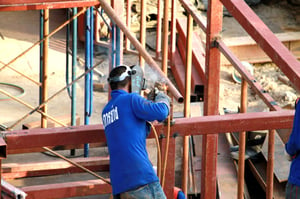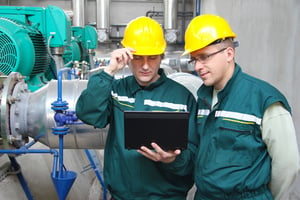
As the summer months arrive, an increased amount of outdoors maintenance and general activity can take place on work sites. Meanwhile, indoor working areas can experience higher temperatures and less pleasant working conditions, as heat and humidity creeps in.
For those businesses that are based in warmer regions, this can mean an additional set of precautions and measures that should be taken to avoid compromising employee or public health.
How a business responds to differing temperatures and environmental conditions is all part of the ongoing “stress-test” of a functioning health and safety management system. Businesses need to be able to ensure their health and safety management can react to soaring temperatures, the dangers of sunstroke and heat exposure, dehydration, and any material temperature based hazards – particularly those involving volatile chemicals.
This piece will explore the kind of robust systems that need to be in place to counter these kinds of seasonal conditions.
Rising Temperatures - Rising Threats
The impact of the summer season on activities that take place both around and within industrial facilities can be considerable. Temperatures in the continental United States can easily soar upwards of 80 Fahrenheit in summer month. With a record-breaking surge in temperatures being reported in recent years, the prospect of numerous hot summers looks increasingly likely.
Increasing temperatures can impact directly on the physical work environment. Putting the direct effects on human physiology to one side for a moment, increased heat can subtly but crucially the operations of an industrial facility on a number of levels.
Slippage, melting materials and sun glare all become more common, but sensitive materials are a particular concern. Increased heat can have unexpected effects on industrial components, chemicals and hazardous materials. As a minimum, regular safety audits should be able to insure that temperature control measures are in place for all containers, particularly those that are directly exposed to sunlight and the elements.
The prospects of chemical reactions or build-ups of hazardous vapor are scenarios that can be directly connected to increased sunshine and heat. In this regard, the threat posed by higher temperature and summer conditions can often lurk unseen, but have real consequences.
The impact of summer weather and heat can also have a considerable impact on firefighting scenarios at industrial sites, should a fire break out. Summer conditions, with hot conditions and dry winds, can exacerbate fire scenarios. This was the case in the 1988 PEPCON fuel production plant disaster, where hot conditions exacerbated a reported fire that played a key role in a major industrial incident.
In this regard, managing summer conditions should form part of a unitary health and safety management system, one which through proper auditing and modeling, catches the real risks.
Effect of Heat on Attention, Adherence, Efficiency

Summertime heat can have a number of effects that physically manifest themselves amongst workers. The direct impact of hotter and more energy-sapping conditions can be felt across a wide swathe of industry, particular in states with drier or desert climates.
The most common effects of higher summer temperatures include a more frequent prevalence of dehydration, heatstroke, sunburn, and general discomfort. Not foreseeing and accounting for higher temperatures can result in a range of detrimental outcomes, ranging from distracted and inattentive staff to the occurrence of serious medical incidents, such as serious sunstroke. Increased heat has been linked to inattention, rush jobs, and can contribute negatively to safety observance. OSHA, the Occupational Safety and Health Administration, specifically states high temperatures can contribute to worker “confusion (and) irrational behavior”, leading to potential injury via a secondary workplace factors (such as a fall from a height).
Additionally, one of the major challenges for progressive businesses is how to combat the impact of increased summer heat through measures that won’t become too much of a burden to bear for the organization. Companies need to balance the need to keep staff cool and content without substantially increasing the costs associated air conditioning, specialist clothes, or protective materials. This goes double for organizations that want to ensure their heat-combative measures are still within the scope of a sustainability strategy.
In this respect, summertime provides a challenge for the combined approach of a sustainable workplace. If you need to provide cold water to a large workforce, and make sure the sourcing, packaging and delivery of that resource is sustainable and responsible, summer will put you under the squeeze. It is a season that can test the most robust of strategies.
Perhaps the most cohesive approach is to double-down on the planning and measurement of data – allowing your workplace to see what the numerical summertime needs are, in terms of AC output and heat relief, and then go about pursuing these in the most efficient manner.
Systemic Response
An over-arching health and safety management regime should be able to react automatically to the occurrence of extreme summer heat. The response should be in both a proportional and efficient manner, while any measures that need to be taken should form part of well-rehearsed process.
The modern workplace offers numerous ways to react proactively to temperature conditions. The use of CEMS (Continuously Emissions Monitoring Systems) is now an established practice in many industrial workplaces. As the name suggests, these devices deliver data continuously on what emissions are being released from a facility.
Similar set-ups, involving thermometers and humidity readings can be used to feed a constant flow of information to a monitoring system, or to HR module that will pick up on a temperature threshold. Established protocols should be in place to ensure that should a threshold be breached, corrective measures (e.g. more frequent water breaks, or a cessation of work) should be instituted.
A responsible approach to high temperatures doesn’t need to be high tech. Through better training and education of staff that may be exposed to these conditions, companies can empower workers to take the most sensible and safety-focused measures.
With conditions like this being something that workers will viscerally experience, company policy will be something that will come under the spotlight from individual workers. Having a sensible policy that puts employee well-being first will contribute considerably to worker morale.
Conclusion

Ultimately, provisioning for hotter working conditions should be part of an inclusive strategy. Not just a health and safety issue, as outlined above, it is a factor that can have a “knock-on” effect that touches sustainability, HR, storage and surveillance policies, plus inspection routines.
Extremes of weather are a fact of life, and have been part of life in North American workplaces for many decades. With the imposition of a system that can react to hard data swiftly, as well as encourage more sensible actions through regular training, a modern workplace equipped with a comprehensive health and safety management system can take even extreme weather in its stride.
For more on how a comprehensive approach to health and safety can help your business overcome these difficulties, visit the ERA Environmental website section on combined Health and Safety measures. We would be happy to set up a completely free, no-obligation demo of our health and safety management modules, completely at your convenience.
This Blog Was Co-Authored By:


Tags:
Incident Management
July 5, 2017



Comments